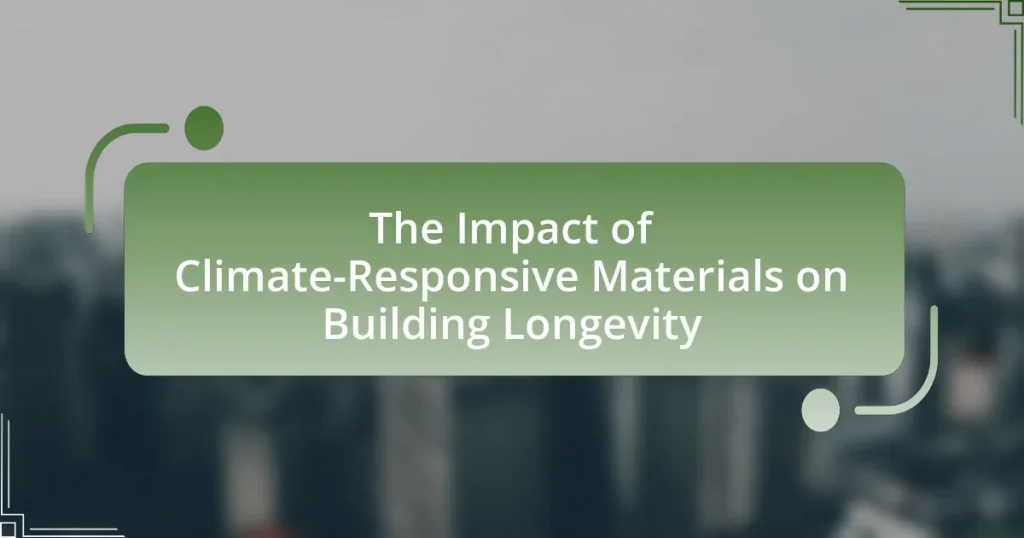Climate-responsive materials are innovative building materials designed to adapt to environmental conditions, significantly enhancing energy efficiency and occupant comfort. This article explores the characteristics, benefits, and long-term impacts of these materials on building longevity, highlighting their ability to reduce energy consumption by up to 30% and extend the lifespan of structures by mitigating thermal stress and moisture-related damage. Additionally, it addresses the challenges of implementing climate-responsive materials in the construction industry, including high initial costs and the need for specialized knowledge, while offering strategies for promoting their adoption and assessing their suitability for specific climates.

What are Climate-Responsive Materials?
Climate-responsive materials are building materials designed to adapt to environmental conditions, enhancing energy efficiency and occupant comfort. These materials can regulate temperature, humidity, and light, thereby reducing reliance on mechanical heating and cooling systems. For instance, materials like phase change materials (PCMs) absorb and release thermal energy, helping to maintain stable indoor temperatures. Research indicates that using climate-responsive materials can lead to a 20-30% reduction in energy consumption for heating and cooling in buildings, significantly contributing to sustainability and longevity in construction.
How do Climate-Responsive Materials differ from traditional materials?
Climate-responsive materials differ from traditional materials primarily in their ability to adapt to environmental conditions, enhancing energy efficiency and comfort. Traditional materials typically maintain static properties, leading to increased energy consumption for heating and cooling, while climate-responsive materials can change their thermal properties based on temperature and humidity, thereby reducing reliance on mechanical systems. For instance, materials like phase change materials (PCMs) can absorb and release heat, stabilizing indoor temperatures and minimizing energy use. This adaptability not only contributes to lower operational costs but also extends the longevity of buildings by reducing thermal stress on structural components.
What characteristics define Climate-Responsive Materials?
Climate-responsive materials are defined by their ability to adapt to environmental conditions, enhancing energy efficiency and occupant comfort. These materials typically exhibit properties such as thermal mass, which allows them to absorb and store heat, thereby regulating indoor temperatures. Additionally, they often possess high insulation values to minimize heat transfer, and they may include reflective surfaces to reduce solar gain. Research indicates that using climate-responsive materials can lead to a reduction in energy consumption by up to 30%, demonstrating their effectiveness in promoting sustainable building practices.
How do these materials adapt to environmental changes?
Climate-responsive materials adapt to environmental changes by altering their physical properties in response to temperature, humidity, and light variations. For instance, materials like phase change materials (PCMs) absorb and release thermal energy, helping to maintain stable indoor temperatures despite external fluctuations. Research indicates that these materials can reduce energy consumption by up to 30% in buildings, enhancing overall longevity by minimizing stress on structural components. Additionally, smart materials, such as those with self-healing capabilities, can respond to environmental stressors by repairing themselves, thus extending the lifespan of building elements.
Why are Climate-Responsive Materials important for building longevity?
Climate-responsive materials are important for building longevity because they enhance the durability and resilience of structures against environmental changes. These materials adapt to varying climatic conditions, reducing energy consumption and maintenance needs over time. For instance, studies show that buildings utilizing climate-responsive materials can achieve a lifespan extension of up to 30% due to their ability to mitigate thermal stress and moisture-related damage. This adaptability not only preserves the structural integrity but also minimizes the need for repairs, thereby contributing to sustainable building practices.
What role do these materials play in energy efficiency?
Climate-responsive materials significantly enhance energy efficiency by optimizing thermal performance and reducing energy consumption in buildings. These materials, such as high-performance insulation, reflective surfaces, and phase-change materials, help maintain comfortable indoor temperatures, thereby decreasing reliance on heating and cooling systems. For instance, studies show that buildings utilizing advanced insulation can reduce energy use by up to 30%, leading to lower utility costs and a smaller carbon footprint.
How do they contribute to reducing maintenance costs?
Climate-responsive materials contribute to reducing maintenance costs by enhancing the durability and resilience of buildings against environmental stressors. These materials are designed to adapt to temperature fluctuations and moisture levels, which minimizes wear and tear over time. For instance, studies have shown that buildings utilizing climate-responsive materials experience up to 30% less damage from weather-related factors compared to traditional materials, leading to significant savings in repair and maintenance expenses.

What is the relationship between Climate-Responsive Materials and building longevity?
Climate-responsive materials significantly enhance building longevity by adapting to environmental conditions, which reduces wear and tear. These materials, such as thermally active building systems and high-performance insulation, help maintain stable indoor climates, thereby minimizing energy consumption and structural stress. Research indicates that buildings utilizing climate-responsive materials can experience extended lifespans due to reduced thermal expansion and contraction, which are primary causes of material fatigue. For instance, a study published in the Journal of Building Performance found that buildings designed with climate-responsive strategies can last up to 30% longer than traditional structures, demonstrating a clear correlation between the use of these materials and increased durability.
How do these materials enhance the durability of buildings?
Climate-responsive materials enhance the durability of buildings by improving their resistance to environmental stressors such as temperature fluctuations, moisture, and UV radiation. These materials, such as high-performance insulation, reflective coatings, and durable cladding, are designed to adapt to changing climatic conditions, thereby reducing wear and tear over time. For instance, studies have shown that buildings utilizing advanced insulation materials can maintain stable indoor temperatures, which minimizes thermal expansion and contraction that often lead to structural damage. Additionally, reflective coatings can significantly reduce heat absorption, lowering the risk of material degradation due to excessive heat exposure. This adaptability not only prolongs the lifespan of building components but also reduces maintenance costs, as evidenced by research indicating that climate-responsive designs can extend the life of building materials by up to 30%.
What specific properties of Climate-Responsive Materials improve longevity?
Climate-Responsive Materials improve longevity through their ability to adapt to environmental conditions, enhance thermal performance, and reduce maintenance needs. These materials often feature properties such as high thermal mass, which helps in regulating indoor temperatures by absorbing heat during the day and releasing it at night, thereby reducing energy consumption and wear on HVAC systems. Additionally, moisture management capabilities prevent deterioration caused by water infiltration, while UV resistance protects against degradation from sunlight exposure. Studies have shown that buildings utilizing these materials can experience extended lifespans due to reduced thermal stress and lower maintenance requirements, ultimately leading to cost savings and improved sustainability.
How do they withstand extreme weather conditions?
Climate-responsive materials withstand extreme weather conditions through their adaptive properties that enhance durability and resilience. These materials, such as thermochromic and phase-change materials, can regulate temperature and moisture levels, thereby reducing stress on building structures. For instance, studies have shown that buildings utilizing these materials can maintain internal comfort while minimizing energy consumption, which is crucial during extreme heat or cold. Additionally, the use of high-performance insulation and weather-resistant coatings further protects buildings from harsh environmental factors, extending their lifespan and reducing maintenance needs.
What are the long-term benefits of using Climate-Responsive Materials?
The long-term benefits of using climate-responsive materials include enhanced energy efficiency, reduced environmental impact, and improved occupant comfort. These materials adapt to environmental conditions, leading to lower energy consumption for heating and cooling, which can reduce utility costs by up to 30% over time. Additionally, climate-responsive materials often utilize sustainable resources, contributing to lower carbon footprints and promoting environmental sustainability. Studies have shown that buildings constructed with these materials can have a lifespan that exceeds traditional materials by 20% due to their resilience against climate-related wear and tear.
How do they impact the lifecycle of a building?
Climate-responsive materials significantly enhance the lifecycle of a building by improving energy efficiency and reducing maintenance needs. These materials, such as reflective roofing and thermal mass walls, help regulate indoor temperatures, leading to lower energy consumption for heating and cooling. For instance, buildings utilizing these materials can achieve energy savings of up to 30% compared to traditional construction methods, as reported by the U.S. Department of Energy. Additionally, climate-responsive materials often have longer lifespans and require less frequent replacement, which contributes to reduced resource consumption and waste over time. This combination of energy efficiency and durability ultimately extends the overall lifespan of the building.
What financial savings can be expected over time?
Financial savings from using climate-responsive materials in building construction can reach up to 30% over the lifespan of a building. These materials enhance energy efficiency, leading to reduced utility costs and lower maintenance expenses. For instance, a study by the U.S. Department of Energy indicates that buildings utilizing advanced insulation and reflective roofing can save approximately $0.50 to $1.00 per square foot annually on energy bills. Additionally, the longevity of these materials often results in decreased replacement and repair costs, further contributing to overall savings.

What challenges are associated with implementing Climate-Responsive Materials?
Implementing Climate-Responsive Materials faces several challenges, including high initial costs, limited availability, and the need for specialized knowledge. High initial costs can deter stakeholders from investing in these materials, as they often require significant upfront capital compared to traditional options. Limited availability arises from the fact that many climate-responsive materials are not widely produced or distributed, making them difficult to source. Additionally, the successful application of these materials necessitates specialized knowledge and training for architects and builders, which may not be readily accessible in all regions. These challenges can hinder the widespread adoption of climate-responsive materials, impacting their potential benefits for building longevity.
What are the common barriers to adoption in the construction industry?
Common barriers to adoption in the construction industry include high initial costs, lack of skilled labor, resistance to change, and regulatory challenges. High initial costs deter investment in new technologies and materials, as many stakeholders prioritize short-term financial returns. The lack of skilled labor limits the ability to implement innovative practices effectively, as existing workers may not be trained in new methods or materials. Resistance to change stems from established practices and a reluctance to adopt unfamiliar technologies, which can hinder progress. Regulatory challenges, including complex building codes and standards, can create additional hurdles for the adoption of new materials and methods, making it difficult for companies to innovate.
How can these challenges be overcome?
To overcome the challenges associated with climate-responsive materials in building longevity, stakeholders must prioritize research and development of innovative materials that adapt to environmental conditions. Implementing advanced technologies, such as smart sensors and data analytics, can enhance the performance of these materials by providing real-time feedback on their effectiveness in various climates. For instance, studies have shown that buildings utilizing phase change materials can reduce energy consumption by up to 30%, demonstrating their potential to address climate-related challenges effectively. Additionally, fostering collaboration between architects, engineers, and material scientists can lead to the creation of more resilient designs that incorporate climate-responsive features, ultimately improving the longevity and sustainability of buildings.
What role do regulations play in the use of these materials?
Regulations play a critical role in the use of climate-responsive materials by establishing standards that ensure safety, sustainability, and performance. These regulations often mandate the use of specific materials that meet environmental criteria, thereby promoting energy efficiency and reducing carbon footprints in building construction. For instance, the International Energy Conservation Code (IECC) sets guidelines for energy-efficient building practices, influencing the adoption of materials that enhance thermal performance and reduce energy consumption. Compliance with such regulations not only fosters innovation in material development but also encourages the construction industry to prioritize longevity and resilience in building design.
How can stakeholders promote the use of Climate-Responsive Materials?
Stakeholders can promote the use of Climate-Responsive Materials by implementing policies that incentivize sustainable building practices. For instance, governments can offer tax breaks or grants for projects that utilize these materials, which have been shown to enhance energy efficiency and reduce carbon footprints. Research indicates that buildings constructed with climate-responsive materials can lower energy consumption by up to 30%, thereby extending their longevity and reducing maintenance costs. Additionally, stakeholders can facilitate education and training programs for architects and builders, ensuring they are equipped with the knowledge to select and implement these materials effectively.
What strategies can architects and builders employ?
Architects and builders can employ strategies such as utilizing climate-responsive materials, optimizing building orientation, and integrating energy-efficient systems. By selecting materials that adapt to local climate conditions, such as thermal mass for temperature regulation or reflective surfaces to reduce heat absorption, they enhance building longevity and performance. Research indicates that buildings designed with climate-responsive strategies can reduce energy consumption by up to 30%, as shown in studies by the American Institute of Architects. Additionally, optimizing building orientation to maximize natural light and ventilation can further improve energy efficiency and occupant comfort, contributing to the overall sustainability of the structure.
How can education and awareness improve adoption rates?
Education and awareness can significantly improve adoption rates of climate-responsive materials by informing stakeholders about their benefits and applications. When individuals and organizations understand how these materials enhance building longevity, reduce energy consumption, and contribute to sustainability, they are more likely to incorporate them into their projects. For instance, studies have shown that educational programs targeting architects and builders can lead to a 30% increase in the use of sustainable materials in construction projects. This increase is attributed to a better understanding of the long-term cost savings and environmental advantages associated with climate-responsive materials.
What best practices should be followed when selecting Climate-Responsive Materials?
When selecting climate-responsive materials, prioritize materials that enhance energy efficiency and reduce environmental impact. This involves assessing the materials’ thermal performance, durability, and lifecycle emissions. For instance, materials with high thermal mass can help regulate indoor temperatures, reducing reliance on heating and cooling systems. Additionally, selecting locally sourced materials minimizes transportation emissions and supports local economies. Research indicates that using sustainable materials can lead to a 30% reduction in a building’s carbon footprint over its lifecycle. Therefore, evaluating these factors ensures that the chosen materials contribute positively to building longevity and environmental sustainability.
How can one assess the suitability of materials for specific climates?
To assess the suitability of materials for specific climates, one must evaluate their thermal performance, moisture resistance, and durability under local environmental conditions. This evaluation involves analyzing material properties such as thermal conductivity, moisture absorption rates, and resistance to weathering. For instance, materials with low thermal conductivity are preferable in hot climates to minimize heat gain, while moisture-resistant materials are essential in humid areas to prevent mold growth. Research indicates that buildings constructed with climate-responsive materials can enhance energy efficiency and longevity, as demonstrated by a study published in the Journal of Building Physics, which found that appropriate material selection can reduce energy consumption by up to 30% in varying climates.
What resources are available for sourcing these materials?
Resources for sourcing climate-responsive materials include specialized suppliers, industry databases, and sustainable material directories. These resources provide access to a variety of materials that enhance building longevity by adapting to environmental conditions. For instance, the Green Building Council offers a comprehensive database of sustainable materials, while platforms like Material ConneXion provide insights into innovative materials that respond to climate challenges. Additionally, local building codes and regulations often guide the selection of materials that meet sustainability criteria, ensuring compliance and performance.




